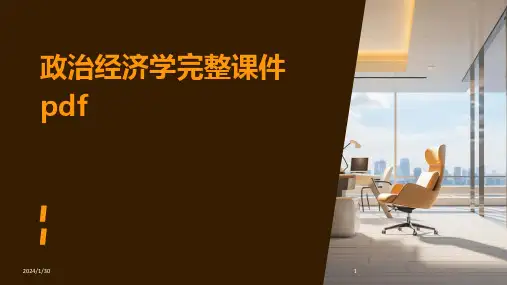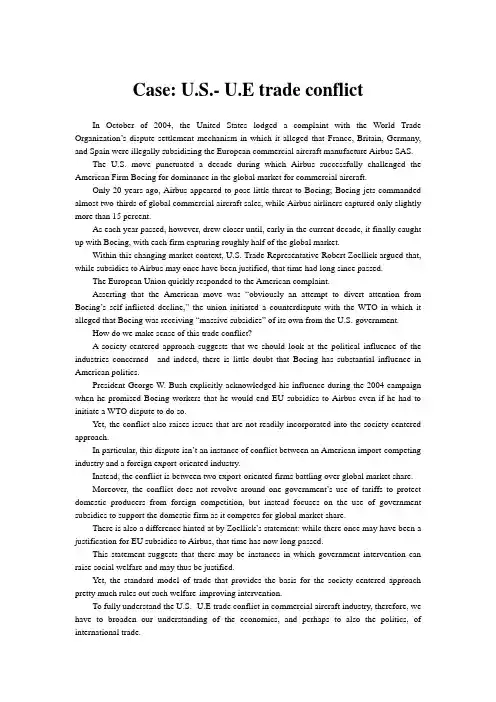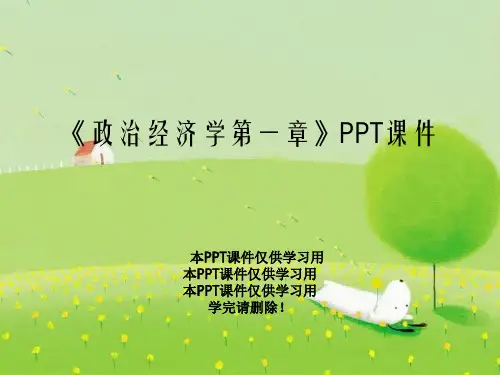厦门大学政治经济学课件
- 格式:ppt
- 大小:75.50 KB
- 文档页数:6








Case: U.S.- U.E trade conflictIn October of 2004, the United States lodged a complaint with the World Trade Organization’s dispute settlement mechanism in which it alleged that France, Britain, Germany, and Spain were illegally subsidizing the European commercial aircraft manufacture Airbus SAS.The U.S. move punctuated a decade during which Airbus successfully challenged the American Firm Boeing for dominance in the global market for commercial aircraft.Only 20 years ago, Airbus appeared to pose little threat to Boeing; Boeing jets commanded almost two-thirds of global commercial aircraft sales, while Airbus airliners captured only slightly more than 15 percent.As each year passed, however, drew closer until, early in the current decade, it finally caught up with Boeing, with each firm capturing roughly half of the global market.Within this changing market context, U.S. Trade Representative Robert Zoellick argued that, while subsidies to Airbus may once have been justified, that time had long since passed.The European Union quickly responded to the American complaint.Asserting that the American move was “obviously an attempt to divert attention from Boeing’s self-inflicted decline,” the union initiated a counterdispute with the WTO in which it alleged that Boeing was receiving “massive subsidies” of its own from the U.S. government.How do we make sense of this trade conflict?A society-centered approach suggests that we should look at the political influence of the industries concerned—and indeed, there is little doubt that Boeing has substantial influence in American politics.President George W. Bush explicitly acknowledged his influence during the 2004 campaign when he promised Boeing workers that he would end EU subsidies to Airbus even if he had to initiate a WTO dispute to do so.Yet, the conflict also raises issues that are not readily incorporated into the society-centered approach.In particular, this dispute isn’t an instance of conflict between an American import-competing industry and a foreign export-oriented industry.Instead, the conflict is between two export-oriented firms battling over global market share.Moreover, the conflict does not revolve around one government’s use of tariffs to protect domestic producers from foreign competition, but instead focuses on the use of government subsidies to support the domestic firm as it competes for global market share.There is also a difference hinted at by Zoellick’s statement: while there once may have been a justification for EU subsidies to Airbus, that time has now long passed.This statement suggests that there may be instances in which government intervention can raise social welfare and may thus be justified.Yet, the standard model of trade that provides the basis for the society-centered approach pretty much rules out such welfare-improving intervention.To fully understand the U.S.- U.E trade conflict in commercial aircraft industry, therefore, we have to broaden our understanding of the economics, and perhaps to also the politics, of international trade.。
![政治经济学完整课件[1]](https://uimg.taocdn.com/fb6cfaa7afaad1f34693daef5ef7ba0d4b736d59.webp)


第二章商品和货币一、关键词商品:用来交换的劳动产品,体现生产者在分工条件下相互交换劳动的社会生产关系。
它由使用价值和价值两个因素构成。
使用价值:指物的有用性或效用,即物能够满足人们某种需要的属性。
它是商品的自然属性,构成社会财富的物质内容,体现人与自然的关系。
商品的使用价值是交换价值的物质承担者。
价值:凝结在商品中的无差别的人类劳动。
它是商品的社会属性,体现着商品生产者在私有制和分工条件下互相交换劳动的社会关系。
它是商品的本质属性。
具体劳动:在一定具体形式下进行的劳动,由劳动的目的、对象、工具、方法、结果决定。
它创造商品的使用价值,反映人与自然之间的关系,是人类生存和发展的永恒条件,和自然物质共同构成物质财富的源泉。
各种不同形态的具体劳动是形成人类劳动分工的基础。
抽象劳动:撇开具体形式的无差别的一般人类劳动。
它形成商品的价值,反映商品生产者之间的经济关系,是劳动的社会属性,是商品经济特有的范畴。
社会必要劳动时间:在现有的社会正常生产条件下,在社会平均的劳动熟练程度和劳动强度下制造某种使用价值所需要的劳动时间。
劳动生产率:衡量劳动者生产某种产品的效率或能力的指标。
一般用单位时间内生产的产品数量来表示,也可以用生产单位产品所耗费的劳动时间来表示。
简单劳动:指不需要经过专门培养和训练的一般劳动者能从事的劳动。
复杂劳动:指需要经过专门培养和训练,具有一定文化知识和技能的劳动者才能从事的劳动。
私人劳动:指生产商品的劳动具有私人性质,商品生产者为实现私人利益而自己进行的劳动。
商品生产劳动的私人性质是由生产资料的私有制或局部独立经济利益决定的。
社会劳动:指商品生产者的劳动具有社会性质,在社会分工体系下作为社会总劳动的组成部分,为他人或社会需要生产使用价值的劳动。
商品生产劳动的社会性质是社会分工所赋予的。
商品拜物教:指商品形式在人们面前表现出的支配商品生产者命运的神秘性质。
它是商品形式所体现的社会生产关系在人们头脑中的歪曲反映。